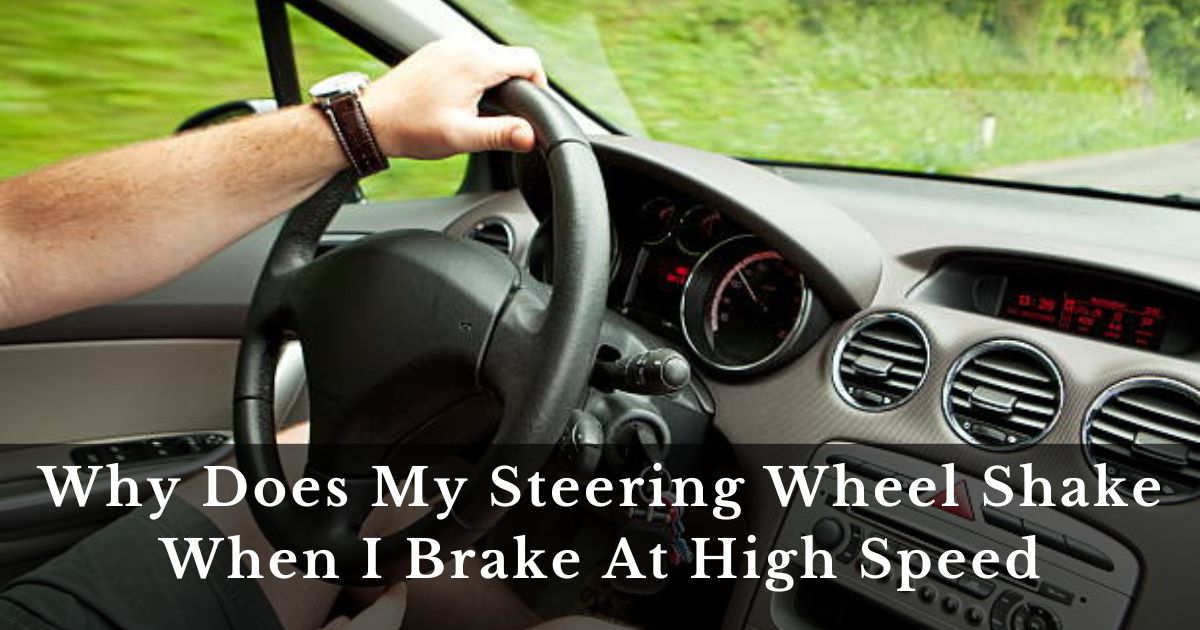Why does my steering wheel shake when I brake at high speed, Driving usually feels smooth, but sometimes, your steering wheel shakes when you brake fast. This can be scary and might be risky. Let’s look at why this happens and how you can fix it.
Have you ever felt your steering wheel shaking when you hit the brakes at high speeds? It’s a common issue that many drivers face, and it can be quite alarming. This article will delve into the reasons behind this unsettling phenomenon and provide insights into how to address it.
Common Causes of Steering Wheel Shaking
Understanding the root cause of steering wheel shaking is crucial for effective troubleshooting. Let’s explore some common reasons.
Warped Brake Rotors
One of the most frequent culprits behind steering wheel shaking is warped brake rotors. Over time, the heat generated from braking can cause the rotors to warp, leading to vibrations that are felt in the steering wheel.
Unbalanced Tires
Another potential cause is unbalanced tires. When tires are not properly balanced, they can cause the steering wheel to shake, especially when braking at high speeds.
Worn Suspension Components
Worn-out suspension components can also contribute to steering wheel shaking. Damaged shocks or struts can lead to unstable handling and vibrations in the steering wheel.
Loose or Damaged Steering Parts
Loose or damaged steering parts, such as tie rods or ball joints, can also be to blame. These components play a crucial role in steering control, and any issues with them can result in steering wheel vibrations.
Signs and Symptoms to Look For
Being aware of the signs and symptoms can help you identify steering wheel shaking early on.
Vibrations in the Steering Wheel
The most obvious symptom is feeling vibrations in the steering wheel when braking. These vibrations can range from subtle to severe, depending on the underlying issue.
Noise When Braking
Unusual noises, such as grinding or squealing, when braking can also indicate a problem. These noises are often accompanied by steering wheel shaking.
Pulling to One Side
If your vehicle pulls to one side when braking, it could be a sign of uneven brake wear or alignment issues, which can cause steering wheel shaking.
Potential Risks of Ignoring the Issue
Ignoring steering wheel shaking can lead to various risks that can compromise your safety and vehicle’s performance.
Reduced Braking Efficiency
One of the immediate risks is reduced braking efficiency. Steering wheel shaking often indicates brake problems that can impair your ability to stop quickly and safely.
Accelerated Wear and Tear
Continued driving with steering wheel shaking can accelerate wear and tear on various components, leading to costly repairs down the line.
Safety Concerns
Perhaps the most critical risk is safety. Steering wheel shaking can compromise your ability to control the vehicle, especially in emergency situations.
How to Fix Steering Wheel Shaking
Addressing steering wheel shaking involves identifying the root cause and taking appropriate corrective measures.
Brake Inspection and Repair
Start by inspecting the brake system for issues like warped rotors or worn-out brake pads. Replace any damaged or worn components to restore optimal braking performance.
Tire Balancing and Rotation
Have your tires balanced and rotated regularly to ensure even wear and proper alignment. This can help minimize steering wheel shaking caused by unbalanced tires.
Suspension Check and Repair
Check the suspension system for any signs of wear or damage. Replace worn-out shocks or struts and ensure all components are in good condition to reduce steering wheel vibrations.
Steering System Inspection
Inspect the steering system for loose or damaged parts. Tighten or replace any components as needed to restore steering control and eliminate shaking.
Preventive Measures to Avoid Steering Issues
Taking preventive measures can help you avoid steering wheel shaking and maintain optimal vehicle performance.
Regular Maintenance
Schedule regular maintenance checks to inspect the brake system, tires, suspension, and steering components. This can help identify and address issues before they escalate.
Timely Inspection and Repairs
Don’t ignore any signs of steering wheel shaking or other unusual symptoms. Address them promptly by seeking professional inspection and repairs.
Safe Driving Habits
Practice safe driving habits, such as avoiding hard braking and maintaining a safe following distance. This can help reduce wear and tear on your vehicle’s components and minimize the risk of steering wheel shaking.
Steering wheel shaking when braking at high speeds is a common issue that can be caused by various factors, including warped brake rotors, unbalanced tires, worn suspension components, or loose steering parts. Ignoring this issue can lead to reduced braking efficiency, accelerated wear and tear, and safety concerns.
By identifying the root cause and taking appropriate corrective measures, such as brake inspection and repair, tire balancing and rotation, suspension check and repair, and steering system inspection, you can address steering wheel shaking effectively. Additionally, practicing preventive measures and safe driving habits can help you avoid steering issues and maintain optimal vehicle performance.



